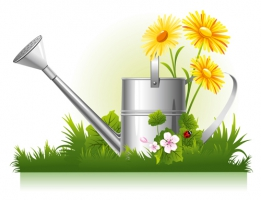Flower gardening in Sun City can be challenging for a number of reasons but it can also be equally rewarding. The most immediate challenges to flower gardening involve choosing the right plant and protecting it from those pesky  bunny rabbits and birds. Protection usually involves some sort of fencing, netting or enclosed patio or courtyard. Look around, you’ll see plenty of examples. To aid in plant selection we recommend relying on reputable nurseries for advice. And if you are someone who likes to do their research before shopping, then we highly recommend the local publication “Landscape Plants for the Arizona Desert”. It is published by your local AMWUA Water Conservation Office and may be found online here: http://www.amwua.org/plants/ . The Garden Club also strives to keep paper versions of the publication on hand at our office. Call ahead to make certain we have copies in stock. And if you are someone who ‘needs to see it before they buy it’, our club offers tours of local gardens, botanical sites and educational opportunities to learn how to grow a wide variety of flowering plants in our desert setting and how to troubleshoot problems.
bunny rabbits and birds. Protection usually involves some sort of fencing, netting or enclosed patio or courtyard. Look around, you’ll see plenty of examples. To aid in plant selection we recommend relying on reputable nurseries for advice. And if you are someone who likes to do their research before shopping, then we highly recommend the local publication “Landscape Plants for the Arizona Desert”. It is published by your local AMWUA Water Conservation Office and may be found online here: http://www.amwua.org/plants/ . The Garden Club also strives to keep paper versions of the publication on hand at our office. Call ahead to make certain we have copies in stock. And if you are someone who ‘needs to see it before they buy it’, our club offers tours of local gardens, botanical sites and educational opportunities to learn how to grow a wide variety of flowering plants in our desert setting and how to troubleshoot problems.
For many years, Sun City has been known for one specialized variety of floral gardening – roses – and until recently sported a club devoted to rose care. Then, in 2014 the Rose and Garden Club merged with the Garden Club of Sun City to pursue our common Sun City gardening interests. Therefore, our Rose Committee was formed to develop programing related to flower gardening and care of the Sun Bowl Rose Garden on N 107th at Clair Drive in Sun City and in the special Rose plot in the Community Garden at the corner of Greenway Road and 91st Avenue. The following care instructions are a result of years of member experience and offered here for your benefit in growing beautiful roses.
Monthly Rose Care
January – Plant new rose bushes, transplant bushes if needed, prune established bushes. Severely prune roses back to about eight strong canes, removing all twiggy growth and all leaves. Seal ends of canes with Elmer’s Glue or something similar to protect the cut ends from infection and infestations. Shut off all irrigation during prolonged wet periods.
February – Feed Epsom Salts to roses by adding 1 teaspoon of Epsom Salts for each foot height of your bush. Make sure soil is wet before fertilizing and water again after fertilizing. Set irrigation to one a week for about 15-20 minutes at a time. Spray for aphids, thrips and mildew.
March – Continue feeding roses, 1/3 cup every two weeks. Water new bushes every 3-4 days. Watch roses for insect damage and spray if needed. Deadhead roses when needed.
April – Blooms should be popping open. Set irrigation for spring schedule – twice a week. Continue rose food and spray for insects as needed. Deadhead roses when needed. Put Elmer’s Glue on all cut canes. Chelated iron may be needed if leaves are turning yellow with green veins. Increase watering if weather turns very hot and dry.
May – Decrease rose food to ¼ cup every three weeks. Deadhead and seal canes when needed. Mulch roses to a depth of 2-4 inches before hot weather begins. Use cedar chips and not rock mulch around the base of the bushes. Bugs have no taste for cedar and rocks can burn the bushes. Watch for spider mites on the underside of the leaves and, if discovered, wash off with a water wand three days in a row. Water deeply twice a week.
June – Continue rose food. Add 1/3 cup of gypsum per bush to roses. Begin summer schedule of watering of three times a week for at least 30 minutes at a time.
July – Continue heavy watering of roses. Discontinue deadheading roses until September.
August – Continue heavy watering of roses and add 1/3 cup of gypsum per bush.
September – Midmonth, prune out dead and crossover growth. Generally thin rose bushes. Later in the month, add iron chelate at 1 teaspoon per bush. Add 1 teaspoon of Epsom Salts for each foot height of your bush.
October – Adjust watering to temperature change. Continue feeding rose food – 1/3 cup every two weeks. Deadhead roses when needed.
November – Slow down watering of roses. Discontinue fertilizer around November 1. Deadhead roses when needed.
December – Turn off irrigation if it rains. Sit back and enjoy the new rose catalogs. Plant bare root roses the last week of the month or the first week of January.
Some people prefer using natural or organic treatments on their plants rather than the chemicals. If you are one of those people, try asking a reputable nursery for suggestions for alternatives to chemical sprays.
******************************************************

